BOP's 50 Favorite Horror Films: 20-11
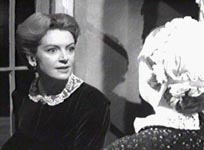 20) The Innocents
20) The Innocents
This 1961 black and white film that was adapted from the Henry James novella Turn of the Screw makes the argument that the unknown is scarier than the known and that often ambiguity cuts much deeper than any in-your-face terror. Deborah Kerr plays a young governess who takes the job of looking after two young children who live in a cold, forbidding mansion. Once there, she begins to feel as though there may be something odd about the kids, some lurking evil inside them which may be manifesting itself, due perhaps to past events that occurred in these sepulchral surroundings. But does the evil truly lie in the outside world, or, on the other hand is it the governess herself whose madness is causing her to impart wickedness to those who are simply normal? Is it Victorian repression that leads the descent into hysteria, or are the youngsters really demonic, nefarious spawn? Neither James nor director Clayton ever really give a solid answer to these questions, and this delicious lack of clarity merely adds to the vibrant tension of this eerie classic. Also contributing to the creepy style of this great cinematic offering is the gorgeous cinematography of Freddie Francis (who continued to work through the 90's on such films as the Cape Fear remake and David Lynch's The Straight Story) and wonderful acting by Kerr and her two young charges. Overall, this is a quiet ghost story where the menace remains insubstantial and nebulous, a tale where questions of existence and reality loom beneath the surface of the genre trappings. Current moviegoers who find themselves drawn to films more along the lines of The Others (a film which bears somewhat more than a passing resemblance to The Innocents) than shocking gorefest might want to take a chance on this one. (Chris Hyde/BOP)
|
|
|
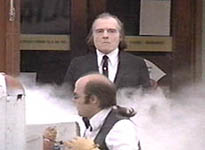 19) Phantasm
19) Phantasm
Phantasm is that rarest of horror films, one with a truly original premise. And while it contains some elements of standard horror fare, Phantasm puts them together in new ways, and adds its own iconic entries to the horror pantheon.
The villain of the piece, the Tall Man, is one of the all-time great scary monsters. As a site-mate put it, the Tall Man is one of the creepiest film presences ever. He will haunt your dreams long after the final frame, and interestingly enough, we never discover if he is human or ghoul. Then there are the Flying Silver Balls, which rank amongst the coolest - if not in fact the coolest - instruments of mayhem ever (and, as the aforementioned site-mate pointed out, a rather well-done effect given the budget of the film), gory little dispensers of death and destruction that are way too fun to watch. Add in a number of major twists at several key plot points, including the end, and you've got a low-budget scarer that really delivers the goods. As if all that weren't enough, Phantasm provides a life-lesson worth taking from the theater in the form of one character's rule for the use of firearms: Never pick up a gun unless you plan to shoot it, and never shoot a gun unless you shoot to kill.
Or in the words of my site-mate, four-barreled shotgun = boom. (Stephanie Star Smith/BOP)
|
|
|
 18) Jaws
18) Jaws
I suppose there may be some quibbling about whether this is technically a horror movie. Is it more of a thriller? An adventure movie? I suppose my response to that is, if it isn't a horror movie, then why did it scare the crap out of me? Though I never quite understood how people claimed they were afraid to take a shower after seeing Psycho, to this day I still can't swim in the ocean without at least once hearing that famous John Williams score and having a mini freak-out. Jaws earns its place in horror history by not only frightening me in the theater, but by being the only movie ever to instill in me what is sure to be a lifelong fear. (Dan Krovich/BOP)
How Well Do You Know: Jaws
|
|
|
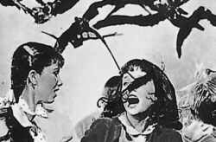 17) The Birds
17) The Birds
Vertigo, North By Northwest, Psycho, The Birds. These four films, released from 1957-1963, create a four-film arc that solidified Alfred Hitchcock as the legend he remains today.
The last film in the series, The Birds, is of one Hitchcock's spookiest movies and quite possibly his darkest. It's one of his most analyzed, too, with a simple, basic, almost generic idea made special by his touch. In today's horror films, a beefy, shirtless protagonist (or David Arquette) finds the source of the creature infestation, destroys it, and everyone lives happily ever after. There are no happy endings in Mr. Hitchcock's world. That's breaking the rules, which is a good thing.
The three year gap between Psycho and this film was the longest in Hitchcock's career at the time, owing to the script preparation and attention to technical detail he needed for The Birds. Even with the extreme (for the time) cinematic demands, the final result is still up to the high standards one of the greatest directors ever always set for himself. (Tim Briody/BOP)
|
|
|
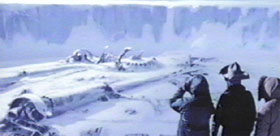 16) The Thing
16) The Thing
--So this guy is having a heart attack. They clear a table and lift him onto it. The doctor grabs some resuscitation paddles, places them against the guy's chest and yells clear. He flicks the switch and a jolt runs through the guy on the table. Nothing. His paddles recharge, he hits the switch again and...
The sequence that follows is one of the most memorable in the film. A stomach-churning escalation of biological horror. At its climax, the infamous spider-head, the on-screen, "You got to be fucking kidding", echoes exactly what the shell-shocked viewer is thinking. A lot of horror films rely on suspense and shadow-shrouded glimpses of the creature to crank up the fear factor. Not The Thing. There is some suspense there, claustrophobia and paranoia, but the horror of the film is the creature itself.
The endless permutations of flesh and goo that are The Thing are usually attributed to two men: Storyboarder Michael Ploog and Special Make-up Effects Supervisor Rob Bottin. Bottin used every pre-CGI trick in the book to bring the disgusting creations of Ploog's imagination to life. It is the success with which these designs are transferred to the screen that raises The Thing from a run-of-the-mill horror scenario to a well-deserved place on this list. (Ash Wakeman/BOP)
--Make no mistake about it, the effects are meant to be the star of this movie. While computer graphics have now rendered the prosthetic effects in this movie more or less obsolete, John Carpenter's The Thing was a state-of-the-art surreal freakfest at the time of its release. Speaking of surreal, I would have paid anything to be sitting in a theatre next to Wilford Brimley, watching himself star in a movie that features a disembodied head move across the floor with the use of a tentacle-like tongue, then sprout spider legs and scurry away. Effects aside, there is also a good deal of suspense and paranoia as the identity of The Thing - who could be assuming the shape of anyone in an isolated Antarctic research facility - remains hidden in plain sight. (Tad Roebuck/BOP)
|
|
|
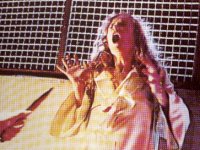 15) Suspiria
15) Suspiria
I was raised on horror films. Been watching them ever since I can remember, even read Famous Monsters of Filmland growing up, and never had trouble sleeping or saw any increase in nightmares through the viewing.
Until Suspiria.
On the surface, this is a simple tale of nefarious doings at a European ballet school, this Dario Argento film is ingenious in creating a brooding and anxiety-filled atmosphere that piles awful event on awful event until the audience can barely breathe. And the beauty of the beast is while each new terror, in and of itself, is not so bad, the combination of the violent acts in the film, along with the spooky score and chilling sound effects, have the cumulative effect of scaring the bejesus out of the audience. After seeing this film, I went home, turned on every light in the house, and then proceeded not to sleep until the sun came up the next day. Even to this day, having not seen it since its original 1977 theatrical release, I can recall the most horrific scenes and the most terrifying plot points; in fact, I'm not sure I can bring myself to watch it again some 25 years later.
And given my love of horror films, that's quite the compliment indeed. (Stephanie Star Smith)
|
|
|
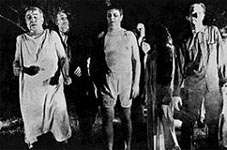 14) Night of the Living Dead (1968)
14) Night of the Living Dead (1968)
The first of George Romero's bloodthirsty zombie films, Night of the Living Dead has spawned any number of copycats and sequels, but it's really a great deal more than just a scary movie.
Filmed in black and white, the film has a starkly realistic feel - it's almost as though you're watching these events unfold on a newscast rather than in a fictional movie setting. The film still holds up well today, even though it was created by a promising young film student back in 1968. Working on a limited budget, the writer/director hired local actors to portray the humans/zombies, and in the process created not only a stirring socio-political commentary, but a film that manages to scare the hell out of us in the process.
As the movie reaches its climax in the farmhouse, the eclectic group that gathers there is forced to deal with a number of decisions - none of them simple. Since there are so many different personalities present, it's easy to identify with the different problems and unique drives for self-preservation each individual goes through. Night of the Living Dead continues to stand as a classic of horror - and the beginning of a distinguished career in zombies for Romero. (Kim Hollis/BOP)
|
|
|
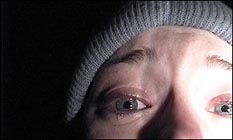 13) The Blair Witch Project
13) The Blair Witch Project
In 1998, two aspiring filmmakers had an idea for a horror movie; instead of getting actors to pretend to be scared, why not actually scare the crap out of them? So, with a loosely defined script, Daniel Myrick and Eduardo Sanchez sent three actors out into the Maryland woods to improvise around the idea of three kids making a documentary about the haunted Blair woods. To achieve the real fear neccesary for this project, the directors snuck around behind the actors and without telling them started to vandalize their camp, make mysterious noises in the distance and generally tried to unnerve them. The brilliant conceit here is that the finished film would be the footage taken by the actors who, in the film's mythology, disappeared on their trip and were never found.
Normally, this kind of no-budget ($35,000-$50,000, depending on who you believe), no-name partially black and white horror film would have been limited to film festivals and a cult audience. However, this was one of the first films to be driven to success by the Internet and had perhaps the most brilliant campaign in the history of cinema. Rumors about the film spread like wildfire; that the actors were actually dead, that the remains of a cabin in the woods suddenly had reappeared... this was a campfire story told on a national scale, to the tune of $140 million.
This is probably the definitive 'love it or hate it' film; either you'll have an instant, visceral reaction to what's happening on-screen or you'll be bored to tears. I'm not sure there's any middle ground here at all. Much of this depends on your ability to empathise with the characters' plight; the idea of being stalked in the night by a mysterious entity in an unfamiliar location gets to the primal fear instinct so thoroughly that those that can put themselves in place of the actors will find it an unsettling experience. Straining to hear what that clanking off in the distance is, wondering if those piles of rocks were coincidence or placed... and then the woods themselves seem to be trying to keep you lost. It's like watching three psychological breakdowns, on film. At the time of its release, I wrote in a review that "this is a film that will make you scared of the dark again." Three years later when I think about this film, I still get a little shudder about having to flick that light switch off. (Reagen Sulewski/BOP)
|
|
|
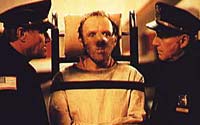 12) Silence of the Lambs
12) Silence of the Lambs
Some performances so overshadow their films that they almost become separate entities in themselves. They become an icon, a cultural touchstone. Anthony Hopkins' Hannibal Lecter is exactly this type of performance, and it's only a supporting role in this film. Watching his performance is quite like watching a caged tiger at the zoo; you feel comforted by the bars but you can't help but be a little scared of the raw power that's represented there. What makes Lecter so fascinating is the contradictions inherent in his character; refined and cultured, he still breaks the ultimate societal taboo of eating his victims. He's still the best psychological mind there is for profiling though, so when the FBI needs help finding another killer, they turn to him, sending rookie FBI agent Clarice Starling (played by Jodie Foster) to appeal to his vanity. How close can you dance with the devil and remain unchanged?
The horror in this film is both psychological, in the danger that Lecter poses to Starling's very identity, and the overt horror of both Buffalo Bill (the serial killer of this film, lest you forget) and Lecter's actions. A film like this could have veered into camp and it still does have a healthy sense of how some of its events are over the top. Jonathan Demme's direction is very assured, though, and lets us focus on the psychological terror with pacing and a restraint that's not ordinary for this kind of film (which often causes people to classify it as something other than horror). Indeed, Demme won the Oscar for this film, along with Hopkins, Foster, screenwriter Ted Tally and the picture itself, one of only three films to achieve this feat. Horror films this good and respectable give the rest of them a bad name. (Reagen Sulewski/BOP)
How Well Do You Know: The Silence of the Lambs
|
|
|
 11) Scream
11) Scream
"What's your favorite scary movie?"
All I have to do is say that line in front of a group of strangers and most of them will titter excitedly in recognition. It has been only six years since the original film was released, yet we have already seen two sequels and dozens of knock-offs, making Scream one of the most impacting movies in recent cinema.
Director Wes Craven was already considered a legend in the realm of horror films, but it wasn't until he took a turn for the satirical that he reached his apex. Utilizing an acerbic script from an unknown writer named Kevin Williamson, the creator of the Nightmare on Elm Street franchise gleefully sent up his own films, along with countless others in the genre, by tweaking all of the conventions and cliches for scary movies.
The only difference between this and the countless volumes of gore flicks which had come before it was self-awareness. Giving his characters the ability to see outside of themselves and recognize their place in the story and the hopelessness which came with it added an exponent of excitement previously unknown to this style of movie. This uniqueness allowed for people to prophesy their own dooms in a manner which was both frightening and amusing to the audience. We knew what would happen in vague terms, but it was this very knowledge which gave Craven a power over the audience. He drew us into the film by making it a guessing game of how he could get from point A to point B in a manner which would somehow surprise an audience he had given omniscience. Few auteurs have ever shown such confidence in themselves and their ability to surprise, but he did exactly this in a dizzying display of artistry.
While the entire film stands on its own merit as a masterpiece, special praise rightly goes to Drew Barrymore. Most actors fight to get bigger parts and line-count their way into satiating their massive egos. She chose the path of reduction here by sagely accepting that the more shocking and noteworthy part would be the one which lasted only one scene. Rather than take the Neve Campbell part and be the protagonist who survives the horror, she talked her way into the role which would become the most shocking death in a horror film since Janet Leigh's Psycho offing some 35 years before.
Movie audiences have been trained to expect that certain stars are too famous to be killed early on in a film, so it's that much more of a stunner when it happens. Scream sets the tone in the opening sequence that it's not a run-of-the-mill horror movie but instead one that will keep movie lovers bewitched throughout. My only bitterness stems from the fact that it fails to crack BOP's top ten horror movies, because to my mind, it's the perfect display of the true beauty of the genre. (David Mumpower/BOP)
How Well Do You Know: Scream
How Well Do You Know: Scream 2
|
|
|
|
|
|
|

